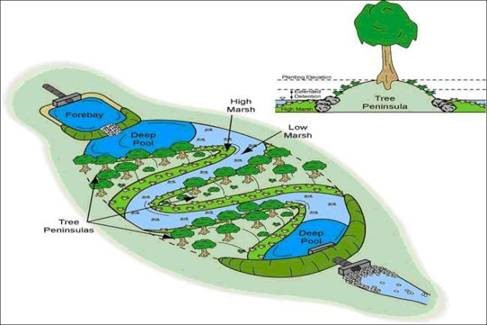Wastewater Treatment Possibilities – Reflections from a Water IGEP guest lecture
The following blog was submitted by James Patrick Wade, a graduate student in BSE, as part of the requirements for GRAD 5414 Water for Health Seminar Interdisciplinary Seminar. This course examines emerging interdisciplinary issues related to the chemistry, microbiology, engineering and health aspects of drinking water.
Dr. Jason He of Virginia Tech’s Civil and Environmental Engineering program visited the group to discuss alternative wastewater treatment techniques. In developed countries, centralized wastewater treatment is effective and efficient due to existing infrastructure like pipes and drainage networks. Piping waste to a single location for treatment defines centralized wastewater treatment. Typically such treatment plants use three levels of processing (primary, secondary and tertiary steps) to produce potable water. Primary treatment involves settling out solids in a sedimentation tank. This is followed or used in conjunction with flocculation of non-settled particulates. Secondary treatment then applies activated sludge (microbial communities) under oxygen-based (oxic) and/or non-oxygenated (anoxic) conditions for removal of solubilized pollutants such as nitrate and phosphate. Finally, the water is disinfected (typically chlorine) and output to streams or holding tanks.
In contrast, developing nations cannot invest the capital or resources on such techniques. Thus, constructed wetlands (Figure 1) may be applied to simply and effectively clean wastewater. This technique removes economic and maintenance issues associated with centralized systems. Constructed wetlands attempt to mimic natural decomposition and degradation of pollutants. Application of raw wastewater to crops is still utilized in some parts of the world. Unfortunately, this opens the possibility for pathogen and disease contamination in food markets. However, if treated wastewater is applied to crops, a twofold solution is created. First, the treated water contains some nitrogen and phosphorus which reduces the fertilizer input needed. Second, costs are kept low as long as rural land is inexpensive. Though the size and capacity of centralized, conventional plants is small, the cost is enormous. In contrast, the cost of decentralized wastewater treatment is minimal while the required land area is enormous.

Overall, developing nations need a combination of both techniques. I recommend centralizing waste treatment in dense, urbanized areas while using land-intensive, low-cost constructed wetlands in the surrounding rural areas. A pragmatic solution exists to keep developing world crop production increasing but also clean (enough) for urban markets.
References
Qadir, M., Wichelns, D., Raschid-Sally, L., McCornick, P. G., Dreschel, P., Bahri, A., & Minhas, P. S. (2010). The challenges of wastewater irrigation in developing countries. Agricultural Water Management, 97, 961-968.
Zhang, D. Q., Jinadasa, K. B. S. N., Gersberg, R. M., Liu, Y., Ng, W. J., & Tan S. K. (2014). Application of constructed wetlands for wastewater treatment in developing countries – A review of recent developments (2000-2013). Journal of Environmental Management, 141, 116-131.
Virginia Department of Environmental Quality (2011). Stormwater Design Specification No. 13: Constructed Wetlands. http://www.vwrrc.vt.edu/swc/NonPBMPSpecsMarch11/VASWMBMPSpec13CONSTRUCTEDWETLAND.html. Accessed: March 9, 2015.


